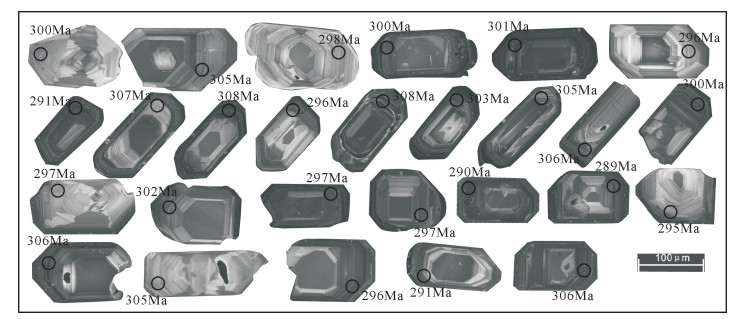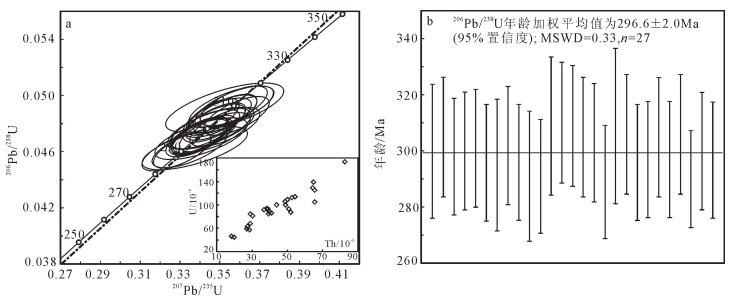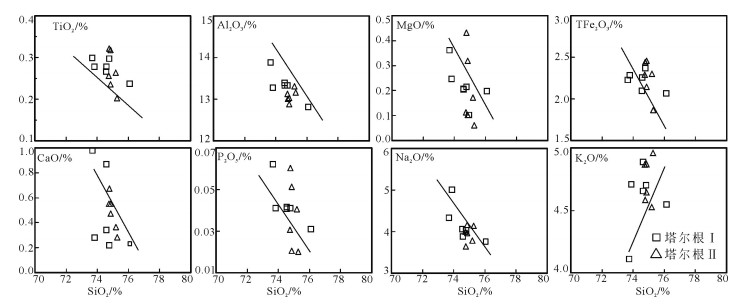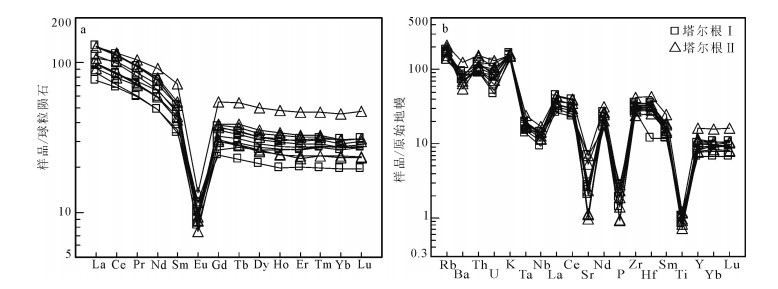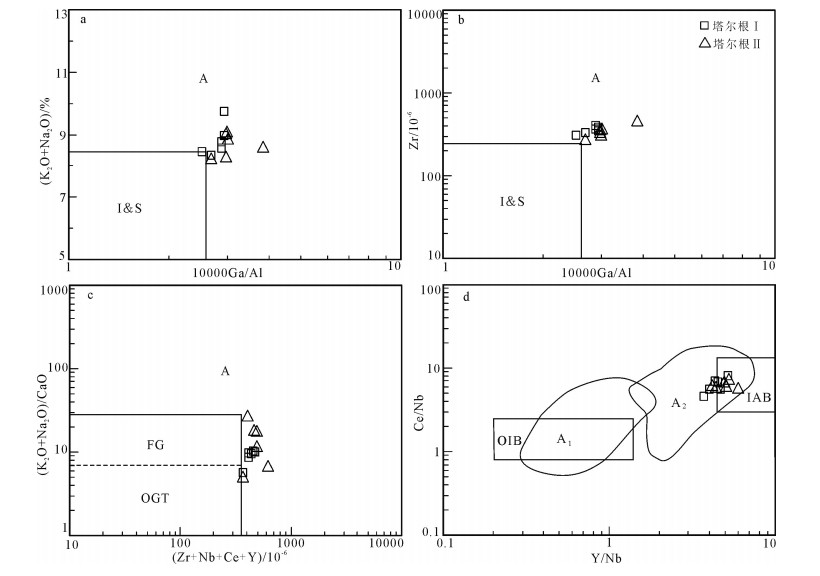Zircon U-Pb chronology, geochemistry of the Taergen granite in Western Junggar, Xinjiang, and their geological significance
-
摘要:
新疆西准噶尔达尔布特构造-岩浆带分布大量的中酸性侵入体,其成因类型和侵位期次对于认识区域岩浆演化具有重要意义。通过对玛依勒山北段塔尔根一带的岩体进行野外地质调查,并结合LA-ICP-MS锆石U-Pb年代学及岩石地球化学分析,确定其形成时代、岩石成因及形成的构造环境。塔尔根一带岩体主要由正长花岗岩和二长花岗岩组成,正长花岗岩锆石U-Pb年龄为296.6±2.0Ma(n=27,MSWD=0.33),属早二叠世早期。岩石地球化学研究表明,其具有高硅、富碱、低钛和铝、贫钙镁,富集大离子亲石元素Rb、Th、K及高场强元素Zr、Hf,强烈亏损Sr、Eu、P、Ti,中等亏损Ba、Nb、Ta等元素,104Ga/Al值及Zr+Nb+Ce+Y含量较高的特征,属碱性准铝质-弱过铝质A型花岗岩,为低压高温条件下长英质地壳物质部分熔融的产物。综合区域构造演化并结合前人认识可知,西准噶尔地区在晚石炭世—早二叠世仍处于俯冲体系,很可能与晚石炭世洋脊俯冲作用有关。
Abstract:There are large numbers of intermediate-acid intrusions distributed along the Darbut tectono-magmatic belt in Western Junggar, Xinjiang. It is of great significance to understand the regional magmatic evolution through their petrogenesis and emplacement periods. The formation time, petronenesis and tectonic setting of Taergen granites, located in the northern part of Mayile Mountain, are reported in this study through field observation, LA-ICP-MS zircon U-Pb dating and geochemical analysis. The Taergen granites are mainly composed of monzonitic granite and syenogranite, LA-ICP-MS zircon U-Pb dating of monzonitic granite yielded an age of 296.6±2.0Ma (n=27, MSWD=0.33), corresponding to early Early Permian. Petrogeochemical analysis indicates that Taergen granites are characterized by high silica, alkali, low titanium and aluminum, lean calcium and magnesium. They are also enriched in large ion lithophile elements (e. g. Rb, Th, K) and high strength field elements (e. g. Zr, Hf) and are strongly depleted in Sr, Eu, P, Ti and mediate depleted in Ba, Nb, Ta, with high 104Ga/Al ratios and Zr+Nb+Ce+Y contents. These features indicate that Taergen granites are metaluminous to weakly peraluminous alkaline series A-type granite, which were originated from the partial melting of felsic crust under high temperature and low pressure conditions. Combined with regional tectonic evolution and previous results, we suggest that the Western Junggar region was still in a subduction-dominated setting in the Late Carboniferous-Early Permian, and probably associated with the ridge subduction during Late Carboniferous period.
-
Keywords:
- A-type granite /
- petrogenesis /
- early Early Permian /
- subduction /
- Western Junggar
-
致谢: 实验测试分析得到长安大学王柱命老师和中国科学院广州地球化学研究所孙胜玲研究员的热情帮助;审稿专家对本文提出了许多宝贵的意见,在此一并致谢。
-
图 7 塔尔根岩体稀土元素配分曲线图(a)和微量元素蛛网图(b)(标准化值据参考文献[48])
Figure 7. Chondrite-normalized REE patterns plot (a) and primitive mantle-normalized trace element spider plot (b) for Taergen granite
表 1 塔尔根Ⅰ号岩体LA-ICP-MS锆石U-Th-Pb分析结果
Table 1 LA-ICP-MS zircon U-Th-Pb isotopic analysis of Taergen granite
点号 同位素比值 同位素年/Ma Th/10-6 U/10-6 Th/U 207Pb/206Pb 207Pb/235U 206Pb/238U 208Pb/232Th 207Pb/206Pb 207Pb/235U 206Pb/238U 208Pb/232Th 比值 1σ 比值 1σ 比值 1σ 比值 1σ 年龄 1σ 年龄 1σ 年龄 1σ 年龄 1σ TEG01 0.05265 0.00271 0.3458 0.0174 0.04763 0.00123 0.01248 0.00167 314 68 302 13 300 8 251 33 38.3 93.9 0.41 TEG02 0.05352 0.00205 0.3581 0.0135 0.04852 0.00114 0.01791 0.00128 351 45 311 10 305 7 359 25 49.9 109.0 0.46 TEG03 0.05318 0.00228 0.3473 0.0146 0.04735 0.00115 0.01074 0.00127 336 53 303 11 298 7 216 25 52.5 112.0 0.47 TEG04 0.05222 0.00220 0.3425 0.0142 0.04756 0.00115 0.01122 0.00138 295 52 299 11 300 7 226 28 54.2 114.0 0.48 TEG05 0.05355 0.00223 0.3524 0.0144 0.04772 0.00114 0.01631 0.00139 352 51 306 11 301 7 327 28 48.4 106.0 0.46 TEG06 0.05244 0.00180 0.3397 0.0116 0.04698 0.00107 0.01217 0.00100 305 39 297 9 296 7 244 18 82.6 174.0 0.48 TEG07 0.05266 0.00303 0.3403 0.0191 0.04687 0.00123 0.01019 0.00204 314 80 297 14 295 8 205 41 27.3 62.7 0.44 TEG08 0.05243 0.00195 0.3469 0.0128 0.04798 0.00112 0.01439 0.00108 304 44 302 10 302 7 289 22 64.2 129.0 0.50 TEG09 0.05235 0.00205 0.3386 0.0131 0.04692 0.00110 0.01507 0.00126 301 47 296 10 296 7 302 25 64.8 139.0 0.47 TEG10 0.05296 0.00350 0.3373 0.0217 0.04619 0.00127 0.01723 0.00286 327 97 295 17 291 8 345 57 18.1 46.2 0.39 TEG11 0.05253 0.00249 0.3345 0.0154 0.04619 0.00115 0.01321 0.00133 309 61 293 12 291 7 265 27 65.4 105.0 0.62 TEG12 0.05247 0.00265 0.3556 0.0176 0.04916 0.00123 0.01467 0.00178 306 68 309 13 307 8 294 35 19.9 45.0 0.44 TEG13 0.05256 0.00208 0.3568 0.0139 0.04924 0.00117 0.01591 0.00127 310 47 310 10 308 7 319 25 50.6 92.8 0.55 TEG14 0.05267 0.00244 0.3571 0.0161 0.04918 0.00122 0.01471 0.00155 315 59 310 12 308 7 295 31 39.2 84.4 0.46 TEG15 0.05184 0.00166 0.3461 0.0110 0.04844 0.00108 0.01629 0.00102 278 36 302 8 305 7 327 20 65.4 125.0 0.52 TEG16 0.05244 0.00189 0.3477 0.0124 0.04810 0.00110 0.01497 0.00121 305 42 303 9 303 7 300 24 39.7 88.3 0.45 TEG17 0.05181 0.00233 0.3279 0.0144 0.04593 0.00112 0.01167 0.00119 277 57 288 11 289 7 235 24 51.9 88.2 0.59 TEG18 0.05205 0.00371 0.3523 0.0244 0.04911 0.00145 0.01604 0.00267 288 104 306 18 306 9 322 53 28.2 57.3 0.49 TEG19 0.05251 0.00202 0.3523 0.0133 0.04868 0.00113 0.01614 0.00127 308 46 306 10 306 7 324 25 48.9 99.9 0.49 TEG20 0.05252 0.00208 0.3404 0.0132 0.04702 0.00110 0.01551 0.00163 308 48 297 10 296 7 311 32 30.1 81.1 0.37 TEG21 0.05236 0.00184 0.3398 0.0118 0.04708 0.00107 0.01606 0.00122 301 40 297 9 297 7 322 24 43.8 99.8 0.44 TEG22 0.05227 0.00215 0.3486 0.0141 0.04839 0.00115 0.01381 0.00142 297 50 304 11 305 7 277 28 40.7 87.0 0.47 TEG23 0.05232 0.00188 0.3398 0.0121 0.04713 0.00107 0.01752 0.00147 299 42 297 9 297 7 351 29 28.8 84.6 0.34 TEG24 0.05242 0.00217 0.3512 0.0142 0.04861 0.00115 0.01277 0.00145 304 51 306 11 306 7 256 29 38.6 92.9 0.42 TEG25 0.05215 0.00189 0.3308 0.0118 0.04604 0.00105 0.01327 0.00142 292 43 290 9 290 6 266 28 36.6 91.7 0.40 TEG26 0.05255 0.00270 0.3446 0.0172 0.04759 0.00120 0.01340 0.00175 309 69 301 13 300 7 269 35 27.1 58.9 0.46 TEG27 0.05260 0.00207 0.3421 0.0132 0.04720 0.00110 0.01580 0.00154 312 47 299 10 297 7 317 31 29.0 68.5 0.42 表 2 塔尔根岩体主量、微量及稀土元素分析结果
Table 2 Major, trace elements and REE contents of Taergen granite
元素 TEGⅠ-1W TEGⅠ-2W TEGⅠ-3W TEGⅠ-4W TEGⅠ-5W TEGⅠ-6W TEGⅡ-1W TEGⅡ-2W TEGⅡ-3W TEGⅡ-4W TEGⅡ-5W TEGⅡ-6W SiO2 74.83 74.63 74.63 73.88 76.13 73.73 74.78 74.85 75.20 74.75 74.85 75.29 TiO2 0.30 0.28 0.26 0.28 0.24 0.30 0.32 0.32 0.26 0.26 0.24 0.20 Al2O3 13.30 13.32 13.38 13.27 12.80 13.87 13.02 12.88 13.31 13.13 13.03 13.16 TFe2O3 2.36 2.25 2.08 2.28 2.06 2.22 2.44 2.46 2.30 2.29 2.14 1.87 MnO 0.03 0.02 0.02 0.03 0.03 0.05 0.04 0.04 0.03 0.02 0.02 0.02 MgO 0.21 0.21 0.20 0.25 0.19 0.36 0.43 0.32 0.17 0.11 0.10 0.06 CaO 0.21 0.34 0.86 0.28 0.23 0.99 0.67 0.47 0.37 0.55 0.55 0.28 Na2O 4.01 4.04 3.86 4.99 3.74 4.31 3.65 3.97 3.78 4.00 4.16 4.14 K2O 4.70 4.89 4.66 4.71 4.55 4.11 4.58 4.64 4.53 4.87 4.87 4.96 P2O5 0.04 0.04 0.04 0.04 0.03 0.06 0.06 0.05 0.04 0.03 0.02 0.02 烧失量 0.71 1.39 1.28 0.79 0.83 1.16 1.18 1.15 1.04 0.86 1.03 0.45 总计 98.93 98.93 99.65 98.66 98.42 98.42 100.67 98.49 99.59 98.67 98.54 99.46 A/CNK 1.10 1.06 1.03 0.96 1.11 1.04 1.07 1.04 1.13 1.02 0.99 1.04 R1 2391.31 2327.51 2449.29 1983.36 2619.42 2354.26 2542.09 2419.99 2540.08 2355.35 2306.63 2330.70 R2 294.20 307.49 364.82 301.92 284.72 395.39 348.70 318.95 308.67 322.03 319.90 291.30 TZr/℃ 878.88 869.13 860.10 844.62 863.11 844.45 840.33 891.23 875.33 864.38 852.36 849.36 AR 4.63 4.78 3.98 6.03 4.50 3.62 4.02 4.63 4.10 4.68 4.97 5.19 Ga 20.02 20.50 20.24 20.37 17.98 18.25 18.02 25.64 20.54 20.43 20.00 20.42 Rb 105.70 114.40 105.00 110.20 102.20 84.69 99.19 135.10 91.73 116.00 112.30 125.60 Sr 53.91 54.82 57.10 61.96 43.13 144.40 112.00 146.50 49.37 23.12 20.54 23.70 Y 36.50 45.78 45.84 39.28 41.36 30.58 35.79 73.08 52.05 49.28 48.24 35.15 Ti 1373.50 1304.90 1272.10 1301.90 1083.20 1340.80 1508.60 1551.10 1262.20 1184.30 1076.90 951.90 Zr 390.00 371.20 349.90 333.60 322.60 100.80 273.00 468.60 363.70 368.90 338.50 309.90 Nb 9.59 10.23 9.49 9.59 7.80 6.58 8.14 12.18 10.28 10.03 9.19 8.47 Cs 1.96 2.58 2.40 2.30 1.85 1.59 2.20 1.64 1.53 2.17 2.51 1.98 Ba 593.10 583.30 504.90 530.80 660.60 554.60 541.20 868.30 482.30 445.60 389.20 494.00 Hf 10.70 10.20 9.43 9.61 8.90 3.67 7.82 13.28 10.04 10.22 9.04 8.73 Ta 0.69 0.81 0.75 0.77 0.61 0.57 0.70 0.98 0.71 0.76 0.70 0.69 Pb 19.85 19.20 14.34 14.13 11.61 10.24 13.09 17.53 12.35 18.66 17.24 12.81 Th 7.68 10.76 8.48 10.03 7.97 8.25 12.36 13.19 8.09 9.64 9.54 9.13 U 1.75 1.70 1.33 2.56 0.97 1.11 2.24 2.75 1.52 1.99 2.13 1.79 La 17.96 30.52 23.14 23.43 26.57 20.27 21.64 30.25 25.39 30.39 30.11 23.40 Ce 42.20 69.41 51.32 51.50 60.76 43.46 48.74 71.55 62.41 69.06 68.63 52.34 Pr 5.61 8.95 7.18 6.80 7.75 5.71 6.71 9.95 8.14 9.02 8.90 6.83 Nd 22.60 35.63 30.20 27.37 30.89 22.73 27.59 42.52 33.40 36.77 35.82 27.71 Sm 5.44 7.97 7.32 6.32 7.02 5.21 6.68 11.00 7.97 8.33 7.98 6.34 Eu 0.47 0.58 0.60 0.52 0.54 0.67 0.68 0.79 0.54 0.51 0.51 0.43 Gd 5.34 7.68 7.27 6.09 6.67 4.99 6.29 11.18 7.93 7.92 7.52 6.10 Tb 1.01 1.29 1.24 1.09 1.16 0.84 1.06 2.03 1.44 1.38 1.31 1.05 Dy 6.67 8.11 7.80 6.88 7.32 5.35 6.65 12.75 8.93 8.54 8.07 6.49 Ho 1.47 1.72 1.66 1.50 1.55 1.12 1.37 2.73 1.94 1.85 1.77 1.38 Er 4.41 5.05 4.71 4.35 4.52 3.31 3.96 7.77 5.38 5.24 4.95 3.81 Tm 0.70 0.80 0.73 0.69 0.70 0.51 0.61 1.20 0.83 0.82 0.78 0.61 Yb 4.68 5.21 4.64 4.47 4.63 3.31 4.06 7.71 5.18 5.17 4.85 3.95 Lu 0.71 0.78 0.70 0.69 0.69 0.49 0.60 1.20 0.79 0.79 0.76 0.59 ∑REE 119.29 183.70 148.50 141.69 160.77 117.97 136.64 212.62 170.29 185.79 181.94 141.03 ∑LREE/∑HREE 3.77 5.00 4.16 4.50 4.90 4.92 4.55 3.57 4.25 4.86 5.07 4.88 δEu 0.26 0.22 0.25 0.25 0.24 0.40 0.32 0.17 0.17 0.15 0.16 0.17 (La/Yb)N 2.75 4.20 3.58 3.76 4.12 4.40 3.82 0.89 1.11 1.34 1.41 1.35 (La/Sm)N 2.13 2.47 2.04 2.39 2.44 2.51 2.09 1.09 1.27 1.45 1.50 1.47 (Gd/Yb)N 0.94 1.22 1.30 1.13 1.19 1.25 1.28 1.16 1.23 1.23 1.24 1.24 104Ga/Al 2.84 2.91 2.86 2.90 2.65 2.49 2.61 3.76 2.91 2.94 2.90 2.93 注: TFe2O3表示全铁,TFeO是在去掉烧失量后,按照侵入岩相关标准铁调整计算所得;A/CNK=Al2O3/(CaO+Na2O+K2O)(分子比);AR=(Al2O3+ CaO+Na2O+K2O)/(Al2O3+CaO-Na2O-K2O);δEu=2×EuN/(SmN+GdN);R1=1000×[4Si-11(Na+K)-2(Fe+Ti)];R2=1000×(Al+2Mg+6Ca),式中Si等为9种氧化物(SiO2、Na2O、K2O、FeO、Fe2O3、TiO2、CaO、MgO、Al2O3)的阳离子数; 比值中的下标N为球粒陨石标准化值, 标准化值据参考文献[48]。主量元素含量单位为%,微量和稀土元素含量为10-6 -
韩宝福, 季建清, 宋彪, 等.新疆准噶尔晚古生代陆壳垂向生长(Ⅰ)——后碰撞深成岩浆活动的时限[J].岩石学报, 2006, 22(5):1077-1086. http://www.ysxb.ac.cn/ysxb/ch/reader/view_abstract.aspx?file_no=200605114 Xiao W J, Han C M, Yuan C, et al. Middle Cambrian to Permian subduction-related accretionary orogenesis of Northern Xinjiang, NW China:implications for the tectonic evolution of central Asia[J]. Journal of Asian Earth Sciences, 2008, 32(2):102-117. https://www.deepdyve.com/lp/elsevier/middle-cambrian-to-permian-subduction-related-accretionary-orogenesis-C3BkXNQ5t8
童英, 王涛, 洪大卫, 等.北疆及邻区石炭-二叠纪花岗岩时空分布特征及其构造意义[J].岩石矿物学杂志, 2010, 29(6):619-641. http://www.wanfangdata.com.cn/details/detail.do?_type=perio&id=yskwxzz201006003 尹继元, 袁超, 王毓婧, 等.新疆西准噶尔晚古生代大地构造演化的岩浆活动记录[J].大地构造与成矿学, 2011, 35(2):278-291. http://www.wanfangdata.com.cn/details/detail.do?_type=perio&id=ddgzyckx201102013 高睿, 肖龙, 王国灿, 等.西准噶尔晚古生代岩浆活动和构造背景[J].岩石学报, 2013, 29(10):3413-3434. http://www.ysxb.ac.cn/ysxb/ch/reader/create_pdf.aspx?file_no=20131008&journal_id=ysxb&year_id=2013 Chen J F, Han B F, Zhang L, et al. Middle Paleozoic initial amalgamation and crustal growth in the West Junggar(NW China):Constraints from geochronology, geochemistry and Sr-Nd-Hf-Os isotopes of calc-alkaline and alkaline intrusions in the Xiemisitai-Saier Mountains[J]. Journal of Asian Earth Sciences, 2015, 113:90-109. doi: 10.1016/j.jseaes.2014.11.028
苏玉平, 唐红峰, 侯广顺, 等.新疆西准噶尔达拉布特构造带铝质A型花岗岩的地球化学研究[J].地球化学, 2006, 35(1):55-67. http://www.cqvip.com/qk/92960X/200601/20615024.html Geng H Y, Sun M, Yuan C, et al. Geochemical, Sr-Nd and zircon U-Pb-Hf isotopic studies of Late Carboniferous magmatism in the West Junggar, Xinjiang:Implications for ridge subduction?[J]. Chemical Geology, 2009, 266(3/4):364-389. https://www.deepdyve.com/lp/elsevier/geochemical-sr-nd-and-zircon-u-pb-hf-isotopic-studies-of-late-DNwTTZil6c
庞振甲, 李永军, 赵玉梅, 等.西准阿克巴斯陶铝质A型花岗岩厘定及意义[J].新疆地质, 2010, 28(2):119-124. http://www.wanfangdata.com.cn/details/detail.do?_type=perio&id=xjdz201002001 魏荣珠.新疆西准噶尔拉巴花岗岩地球化学特征及年代学研究[J].岩石矿物学杂志, 2010, 29(6):663-674. http://www.wanfangdata.com.cn/details/detail.do?_type=perio&id=yskwxzz201006005 冯乾文, 李锦轶, 刘建峰, 等.新疆西准噶尔红山岩体及其中闪长质岩墙的时代:来自锆石LA-ICP-MS定年的证据[J].岩石学报, 2012, 28(9):2935-2949. http://www.ysxb.ac.cn/ysxb/ch/reader/create_pdf.aspx?file_no=20120921&journal_id=ysxb&year_id=2012 Gao R, Xiao L, Pirajno F, et al. Carboniferous-Permian extensive magmatism in the West Junggar, Xinjiang, northwestern China:Its geochemistry, geochronology, and petrogenesis[J]. Lithos, 2014, 204:125-143. doi: 10.1016/j.lithos.2014.05.028
胡洋, 王居里, 王建其, 等.新疆西准噶尔庙尔沟岩体的地球化学及年代学研究[J].岩石学报, 2015, 31(2):505-522. http://www.cnki.com.cn/Article/CJFDTotal-YSXB201502016.htm 姜芸, 肖龙, 周佩, 等.新疆西准噶尔红山岩体地质地球化学特征及对下地壳性质的启示[J].地球科学——中国地质大学学报, 2015, 40(7):1129-1147. http://www.wanfangdata.com.cn/details/detail.do?_type=perio&id=dqkx201507003 高山林, 何治亮, 周祖翼.西准噶尔克拉玛依花岗岩体地球化学特征及其意义[J].新疆地质, 2006, 24(2):125-130. http://mall.cnki.net/magazine/Article/XJDI200602006.htm 贺敬博, 陈斌.西准噶尔克拉玛依岩体的成因:年代学、岩石学和地球化学证据[J].地学前缘, 2011, 18(2):191-211. http://www.cqvip.com/QK/98600X/201102/37381753.html 魏少妮, 朱永峰.新疆西准噶尔包古图地区中酸性侵入体的岩石学、年代学和地球化学研究[J].岩石学报, 2015, 31(1):143-160. http://www.ysxb.ac.cn/ysxb/ch/reader/download_pdf.aspx?file_no=20150111&year_id=2015&quarter_id=1&falg=1 Shen P, Shen Y C, Pan H D, et al. Geochronology and isotope geochemistry of the Baogutu porphyry copper deposit in the West Junggar region, Xinjiang, China[J]. Journal of Asian Earth Sciences, 2012, 49:99-115. doi: 10.1016/j.jseaes.2011.11.025
杨钢, 肖龙, 王国灿, 等.西准噶尔别鲁阿嘎希花岗闪长岩年代学、地球化学特征及岩石成因[J].地球科学——中国地质大学学报, 2015, 40(5):810-823. http://www.wanfangdata.com.cn/details/detail.do?_type=perio&id=dqkx201505004 Cao M J, Qin K Z, Li G M, et al. Genesis of ilmenite-series I-type granitoids at the Baogutu reduced porphyry Cu deposit, western Junggar, NW China[J]. Lithos, 2016, 246:13-30. http://adsabs.harvard.edu/abs/2016Litho.246...13C
段丰浩, 支倩, 李永军, 等.新疆西准噶尔库什库都克岩体地质时代、地球化学及岩石成因[J].地质科学, 2017, 52(2):506-525. doi: 10.12017/dzkx.2017.034 康磊, 李永军, 张兵, 等.新疆西准噶尔夏尔莆岩体岩浆混合的岩相学证据[J].岩石矿物学杂志, 2009, 28(5):423-432. http://www.cqvip.com/QK/94932X/200905/31711917.html 晁文迪, 李永军, 王冉, 等.西准噶尔托里县布尔克斯台岩体岩浆混合成因的确认及其地质意义[J].西北地质, 2015, 48(3):149-156. http://www.cnki.com.cn/Article/CJFDTOTAL-YSKW201603003.htm 张连昌, 万博, 焦学军, 等.西准包古图含铜斑岩的埃达克岩特征及其地质意义[J].中国地质, 2006, 33(3):626-631. http://www.wanfangdata.com.cn/details/detail.do?_type=perio&id=zgdizhi200603020 Shen P, Shen Y C, Liu T B, et al. Geochemical signature of porphyries in the Baogutu porphyry copper belt, western Junggar, NW China[J]. Gondwana Research, 2009, 16(2):227-242. doi: 10.1016/j.gr.2009.04.004
唐功建, 王强, 赵振华, 等.西准噶尔包古图成矿斑岩年代学与地球化学:岩石成因与构造、铜金成矿意义[J].地球科学-中国地质大学学报, 2009, 34(1):56-74. https://www.cnki.com.cn/qikan-DQKX200901008.html 段丰浩, 李永军, 王冉, 等.西准噶尔托里县都伦河东岩体埃达克岩特征及其地质意义[J].矿物岩石, 2015, 35(4):8-16. http://www.cqvip.com/QK/94361X/201504/667218479.html 尹继元, 陈文, 肖文交, 等.西准噶尔包古图Ⅰ号岩体的锆石UPb年代学和地球化学特征[J].吉林大学学报(地球科学版), 2016, 46(6):1754-1768. http://mall.cnki.net/magazine/Article/YSXB200906010.htm Shen P, Pan H D. Country-rock contamination of magmas associated with the Baogutu porphyry Cu deposit, Xinjiang, China[J]. Lithos, 2013, 177:451-469. doi: 10.1016/j.lithos.2013.07.019
Yang G X, Li Y J, Yan J, et al. Geochronological and geochemical constraints on the origin of the 304±5 Ma Karamay A-type granites from West Junggar, Northwest China:Implications for understanding the Central Asian Orogenic Belt[J]. International Geology Review, 2014, 56(4):393-407. doi: 10.1080/00206814.2013.847608
Chen B, Arakawa Y. Elemental and Nd-Sr isotopic geochemistry of granitoids from the West Junggar foldbelt (NW China), with implications for Phanerozoic continental growth[J]. Geochimica et Cosmochimica Acta, 2005, 69(5):1307-1320. doi: 10.1016/j.gca.2004.09.019
宋彪, 李锦轶, 张进, 等.西准噶尔托里地区塔尔根二长花岗岩锆石U-Pb年龄——托里断裂左行走滑运动开始的时间约束[J].地质通报, 2011, 30(1):19-25. http://dzhtb.cgs.cn/ch/reader/view_abstract.aspx?file_no=20110102&flag=1 晁文迪, 李永军, 王冉, 等.西准噶尔托里县布尔克斯台岩体岩浆混合的锆石U-Pb年代学证据[J].矿物岩石地球化学通报, 2016, 35(1):99-108. http://www.ysxb.ac.cn/ysxb/ch/reader/create_pdf.aspx?file_no=20130905&journal_id=ysxb&year_id=2013 申萍, 沈远超, 潘成泽, 等.新疆哈图-包古图金铜矿集区锆石年龄及成矿特点[J].岩石学报, 2010, 26(10):2879-2893. http://www.ysxb.ac.cn/ysxb/ch/reader/view_abstract.aspx?file_no=20101001&journal_id=ysxb Jahn B M, Windley B, Natal'in B, et al. Phanerozoic continental growth in Central Asia[J]. Journal of Asian Earth Sciences, 2004, 23:599-603. doi: 10.1016/S1367-9120(03)00124-X
Şengör A M C, Natal'in B A, Burtman V S. Evolution of the Altaid tectonic collage and Paleozoic crustal growth in Eurasia[J]. Nature, 1993, 364:209-304. https://www.researchgate.net/publication/31960368_Evolution_of_the_Altaid_Tectonic_collage_and_Palaeozoic_Crustal_Growth_in_Eurasia
Windley B F, Alexeiev D, Xiao W J, et al. Tectonic models for accretion of the Central Asian Orogenic Belt[J]. Journal of the Geological Society, 2007, 164:31-47. doi: 10.1144/0016-76492006-022
Xiao W J, Santosh M. The western Central Asian Orogenic Belt:A window to accretionary orogenesis an continental growth[J]. Gondwana Research, 2014, 25:1429-1444. doi: 10.1016/j.gr.2014.01.008
李锦轶, 何国琦, 徐新, 等.新疆北部及邻区地壳构造格架及其形成过程的初步探讨[J].地质学报, 2006, 80(1):148-168. http://www.cnki.com.cn/Article/CJFDTOTAL-DZXE200601020.htm Tang G J, Wang Q, Wyman D A, et al. Ridge subduction and crustal growth in the Central Asian Orogenic Belt:Evidence from Late Carboniferous adakites and high-Mg diorites in the western Junggar region, northern Xinjiang (West China)[J]. Chemical Geology, 2010, 277(3):281-300. https://www.sciencedirect.com/science/article/pii/S0009254110002913
辜平阳, 李永军, 张兵, 等.西准达尔布特蛇绿岩中辉长岩LAICP-MS锆石U-Pb测年[J].岩石学报, 2009, 25(2):1364-1372. http://www.wanfangdata.com.cn/details/detail.do?_type=perio&id=ysxb98200906008 Yang G X, Li Y J, Xiao W J, et al. OIB-type rocks within West Junggar ophiolitic mélanges:Evidence for the accretion of seamounts[J]. Earth-Science Reviews, 2015, 150:477-496. doi: 10.1016/j.earscirev.2015.09.002
Zhu Y F, Chen B, Qiu T. Geology and geochemistry of the Baijiantan-Baikouquan ophiolitic mélanges:Implications for geological evolution of west Junggar, Xinjiang, NW China[J]. Geological Magazine, 2015, 152:41-69. doi: 10.1017/S0016756814000168
Tang G J, Wang Q, Wyman D A, et al. Late Carboniferous high εNd(t)-εHf(t) granitoids, enclaves and dikes in western Junggar, NW China:Ridge-subduction-related magmatism and crustal growth[J]. Lithos, 2012, 140/141(5):86-102.
Chen B, Jahn B. Genesis of post-collisional granitoids and basement nature of the Junggar Terrane, NW China:Nd-Sr isotope and trace element evidence[J]. Journal of Asian Earth Sciences, 2004, 23(5):691-703. doi: 10.1016/S1367-9120(03)00118-4
Yuan H L, Gao S, Dai M N, et al. Simultaneous determinations of U-Pb age, Hf isotopes and trace element compositions of zircon by excimer laser-ablation quadrupole and multiple-collector ICPMS[J]. Chemical Geology, 2008, 247(1/2):100-18. doi: 10.1007%2Fs11434-010-3052-4
李献华, 刘颖, 涂湘林, 等.硅酸盐岩石化学组成的ICP-AES和ICP-MS准确测定:酸溶与碱溶分解样品方法的对比[J].地球化学, 2002, 31(3):289-294. http://mall.cnki.net/magazine/Article/DQHX200203009.htm Sun S S, Mcdonough W F. Chemical and isotopic systematics of oceanic basalts:Implications for mantle composition and processes[J]. Geological Society, London, Special Publications, 1989, 42(1):313-345. doi: 10.1144/GSL.SP.1989.042.01.19
Chappell B W, White A J R. Two contrasting granite types[J]. Pacific Geology, 1974, 8(2):173-174. http://faculty.uml.edu/Nelson_Eby/Research/A-type%20granites/Chappell%20and%20White%20S%20and%20I%20type%20granites.pdf
King P L, White A J R, Chappell B W, et al. Characterization and origin of aluminous A-type granites from the Lachlan Fold Belt, southeastern Australia[J]. Journal of Petrology, 1997, 38(3):371-391. doi: 10.1093/petroj/38.3.371
Whalen J B, Currie K L, Chappell B W. A-type granites:geochemical characteristics, discrimination and petrogenesis[J]. Contributions to Mineralogy and Petrology, 1987, 95(4):407-419. doi: 10.1007/BF00402202
Chappell B W, White A J R. I-and S-type granites in the Lachlan Fold Belt[J]. Transactions of the Royal Society of Edinburgh:Earth Sciences, 1992, 83(1/2):1-26.
王强, 赵振华, 熊小林.桐柏-大别造山带燕山晚期A型花岗岩的厘定[J].岩石矿物学杂志, 2000, 19(4):297-306. http://d.wanfangdata.com.cn/Periodical_yskwxzz200004002.aspx Eby G N. Chemical subdivision of the A-type granitoids:Petrogenetic and tectonic implications[J]. Geology, 1992, 20(7):641-644. doi: 10.1130/0091-7613(1992)020<0641:CSOTAT>2.3.CO;2
Frost C D, Frost B R. On ferroan (A-type) granitoids:Their compositional variability and modes of origin[J]. Journal of Petrology, 2011, 52(1):39-53. doi: 10.1093/petrology/egq070
Hofmann A W. Chemical differentiation of the Earth:The relationship between mantle, continental crust, and oceanic crust[J]. Earth and Planetary Science Letters, 1988, 90(3):297-314. doi: 10.1016/0012-821X(88)90132-X
Green T H. Significance of Nb/Ta as an indicator of geochemical processes in the crust-mantle system[J]. Chemical Gelolgy, 1995, 120(3/4):347-359. http://www.doc88.com/p-9455294174057.html
Taylor S R, McLennan S M. The Continental Crust:Its Composition and Evolution[M]. Blackwell Scientific Publication, 1985:57-72.
Green T H. Experimental studies of trace-element partitioning applicable to igneous petrogenesis-Sedona 16 years later[J]. Chemical Geology, 1994, 117(1/4):1-36. https://www.researchgate.net/publication/223945035_Experimental_studies_of_trace-element_partitioning_applicable_to_igneous_petrogenesis--Sedona_16_years_later
Rapp R P, Watson E B. Dehydration melting of metabasalt at 8~32 kbar:Implications for continental growth and crust-mantle recy-cling[J]. Journal of Petrology, 1995, 36:891-931. doi: 10.1093/petrology/36.4.891
Watson E B, Harrison T M. Zircon saturation revisited:temperature and composition effects in a variety of crustal magma types[J]. Earth and Planetary Science Letters, 1983, 64(2):295-304. doi: 10.1016/0012-821X(83)90211-X
Yin J Y, Yuan C, Sun M, et al. Late Carboniferous high-Mg dioritic dikes in western Junggar, NW China:Geochemical features, petrogenesis and tectonic implications[J]. Gondwana Research, 2010, 17(1):145-152. doi: 10.1016/j.gr.2009.05.011
Ma C, Xiao W J, Windley B F, et al. Tracing a subducted ridgetransform system in a late Carboniferous accretionary prism of the southern Altaids:Orthogonal sanukitoid dyke swarms in western Junggar, NW China[J]. Lithos, 2012, 140/141(3):152-165. https://www.researchgate.net/publication/232207100_Tracing_a_subducted_ridge-transform_system_in_a_late_Carboniferous_accretionary_prism_of_the_southern_Altaids_Orthogonal_sanukitoid_dyke_swarms_in_Western_Junggar_NW_China
李菊英, 晋慧娟.新疆准噶尔盆地西北缘石炭纪浊积岩系中遗迹化石的发现及其意义[J].地质科学, 1989, 24(1):9-15. http://cdmd.cnki.com.cn/Article/CDMD-10697-1013251870.htm 晋慧娟, 李育慈.准噶尔盆地西北缘石炭纪生物成因的沉积构造研究[J].科学通报, 1998, 43(17):1888-1891. doi: 10.3321/j.issn:0023-074X.1998.17.024 Wang B, Chen Y, Zhang S, et al. Primary Carboniferous and Permian paleomagnetic results from the Yili Block (NW China) and their implications on the geodynamic evolution of Chinese Tianshan Belt[J]. Earth and Planetary Science Letters, 2007, 263(3/4):288-308. https://core.ac.uk/download/pdf/52761456.pdf
Pearce J A, Harris N B W, Tindle A G. Trace element discrimination diagrams for the tectonic interpretation of granitic rocks[J]. Journal of Petrology, 1984. 25(4):956-983. doi: 10.1093/petrology/25.4.956
Yin J Y, Chen W, Xiao W J, et al. Petrogenesis of Early-Permian sanukitoids from West Junggar, northwest China:Implications for later Paleozoic crustal growth in central Asia[J]. Tectonophysics, 2015, 662:385-397. doi: 10.1016/j.tecto.2015.01.005
Li G Y, Li Y J, Wang X C, et al. Identifying late Carboniferous sanukitoids in Hala'alate mountain, Northwest China:New constraint on the closing time of remnant ocean basin in West Junggar[J]. International Geology Review, 2017, 59(9):1116-1130. https://www.researchgate.net/publication/304576491_Identifying_late_Carboniferous_sanukitoids_in_Hala%27alate_Mountain_Northwest_China_new_constraint_on_the_closing_time_of_remnant_ocean_basin_in_West_Junggar
吴福元, 李献华, 杨进辉, 等.花岗岩成因研究的若干问题[J].岩石学报, 2007, 23(6):1217-1238. http://mall.cnki.net/magazine/article/YSXB200706000.htm Yin J Y, Long X P, Yuan C, et al. A late Carboniferous slab window:Geochronological and geochemical evidence from mafic to intermediate dykes in West Junggar, NW China[J]. Lithos, 2013, 175(176):146-162.




 下载:
下载:

